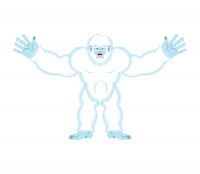Cryptids, a term coined by cryptozoologist John E. Wall in 1983, refer to creatures whose existence is disputed or unconfirmed by mainstream science. These fascinating beings have managed to capture the imagination of many, inspiring countless tales and legends throughout history. Often described as creatures that defy conventional understanding, cryptids continue to provoke curiosity and spark debates among skeptics and believers alike.
Background
Cryptozoology, or cryptozoidology, is the study and identification of creatures once thought to exist but no longer considered credible by scientists. Cryptozoology aims to research and document such creatures that may seem extinct or unknown. Some cryptids such as Yetis and Sasquatch may be better known, while others remain hidden to most of the population at large.
Cryptozoologists play a crucial role in the study of cryptids, employing scientific methods to investigate and document evidence related to these mysterious creatures. By examining eyewitness accounts, analyzing physical traces, and conducting field research, cryptozoologists strive to provide a scientific basis for the existence of cryptids while respecting the boundaries of conventional science.
Historically, “cryptids” referred to legendary creatures not accepted by modern science, such as dragons or unicorns. Later on, however, their meaning has broadened considerably, now including animals once thought of as myths, but now recognized as real (by some people) such as Bigfoot and chupacabra.
Many cryptids have an unnerving appearance and are perceived to be dangerous, while others such as unicorns may even be friendly and beneficial. Cryptids typically live in remote, hard-to-reach regions of the world that make finding them challenging. Their hard to come by nature has contributed to maintaining them as mythical creatures in popular imagination.
The study of cryptozoology began in the 19th century and quickly formalized with technological advancement and organized investigations being established. Travel and exploration helped researchers transition from folklore to cryptozoology. New species like coelacanths were discovered, having disappeared during the Cretaceous period and later reappearing during 1938, rediscovered after 30 million years.
Cryptids may originate in scientific circles, but more frequently they emerge through popular culture and cultural beliefs. A prominent example is Mokele-Mbembe, a water monster resembling Brontosaurus that gained popularity during Africa’s early 1900s due to the creature being linked with Sauropod skeletons displayed at museums globally. Additionally, Europeans in the 18th and 19th centuries often described an Okapi (forest Giraffe), drawing upon images such as those depicted by Europeans when writing descriptions of this cultural cryptid.
Even the gorilla was once considered a cryptid until 1847 when Thomas Savage published a report of his discovery of mountain gorilla bones in Liberia. Even so, mountain gorillas remained mysterious until 1902, when German military officer Wilhelm Leuscher shot one in Virunga and brought back a specimen for study in Europe.
Numerous cryptids have since been confirmed as real animals, such as the Okapi, Duck-billed Platypus and Komodo dragon. All three were considered “cryptids” until definitive evidence for them surfaced. As more cryptids are proven real, their mythological status will fade, leading to greater acceptance of science and the need for skepticism. Cryptid is derived from the Greek root krypto, meaning secret or hidden; fittingly so for animals which have been kept so well hidden.
Cryptozoologists study cryptids to uncover evidence of their existence and to establish whether or not they belong to natural species, while also being curious about any stories and legends surrounding these mysterious beings. As part of their scholarly work, cryptozoologists regularly present their findings at museums or conventions across both America and Europe.
Mothman
The Mothman made its first appearance in Point Pleasant, West Virginia, in the late 1960s. The name “Mothman” was given to this cryptid due to its alleged physical resemblance to a large moth or butterfly. The initial sighting occurred near an abandoned munitions factory, commonly known as the “TNT area,” where witnesses reported encountering a winged creature with glowing red eyes.
Numerous eyewitness accounts have described the Mothman as a humanoid creature standing around 7 feet tall, with large wings spanning up to 10 feet. Its most distinctive feature is its glowing red or amber eyes, which are said to emit an eerie, hypnotic glare. Witnesses often report feeling a sense of dread or impending doom in the presence of the Mothman.
One notable aspect of the Mothman legend is its connection to the tragic collapse of the Silver Bridge on December 15, 1967. The bridge, spanning the Ohio River, connected Point Pleasant to Gallipolis, Ohio. Some believe that the Mothman sightings were a warning or omen of this disaster, as several witnesses claimed to have encountered the creature in the vicinity of the bridge just prior to its collapse.

Loch Ness Monster
The Loch Ness Monster, often referred to as Nessie, is a legendary creature believed to inhabit the deep, dark waters of Loch Ness, a large freshwater lake in the Scottish Highlands. This mysterious creature has captured the imagination of people around the world for decades, sparking countless debates, investigations, and even expeditions to uncover the truth behind its existence.
The Loch Ness Monster is described as a large, long-necked creature with humps protruding from the water. Sightings of Nessie date back to the sixth century, with the most famous photograph allegedly capturing the creature’s long neck and head emerging from the lake’s surface in 1934. However, the authenticity of this photograph, known as the “Surgeon’s Photograph,” has been a subject of intense scrutiny and controversy over the years.
Numerous theories have been proposed to explain the Loch Ness Monster’s existence. Some believe that Nessie is a surviving plesiosaur, a marine reptile that lived during the time of dinosaurs. According to this theory, these prehistoric creatures managed to survive extinction and have been living in the depths of Loch Ness for centuries.
Others argue that the sightings could be attributed to misidentifications, optical illusions, or even hoaxes. The vastness and depth of Loch Ness, coupled with its murky waters, make it challenging to obtain conclusive evidence. Despite numerous scientific investigations, including the use of sonar and underwater cameras, no concrete evidence supporting the existence of the Loch Ness Monster has been found to date.
Bigfoot
The legend of Bigfoot dates back centuries, with indigenous cultures across North America sharing stories of similar creatures. From the Native American tribes’ accounts of wild, hairy giants to various folklore tales, the concept of Bigfoot has deep roots in the cultural fabric of the continent. Exploring these origins helps us understand the significance and enduring allure of this mythical creature.
Over the years, numerous individuals claim to have encountered Bigfoot firsthand. From hikers stumbling upon massive footprints to campers witnessing towering figures lurking in the shadows, these encounters have become the backbone of Bigfoot lore.
Beyond eyewitness testimonies, several pieces of evidence have been presented to support the existence of Bigfoot. Photographs, video footage, and audio recordings have been analyzed and scrutinized by experts and enthusiasts. As interest in Bigfoot grew, scientific investigations began to play a role in the quest for answers. Researchers have employed various techniques, such as DNA analysis, footprint analysis, and audio recordings, to gather evidence and shed light on the mystery.

Yeti
The Yeti, also known as the Abominable Snowman, is a legendary creature that has captured the imagination of people worldwide. This mysterious and elusive monster is said to reside in the Himalayan mountain range, particularly in the snowy and remote regions of Nepal, Tibet, and Bhutan.
The legend of the Yeti dates back centuries, deeply rooted in the folklore and mythology of the Himalayan region. The word “Yeti” itself translates to “magical creature” in the Tibetan language, emphasizing the mystical nature attributed to this creature. Local communities have shared stories and legends about encounters with the Yeti, describing it as a large, ape-like creature with shaggy white fur and enormous footprints.
Over the years, numerous individuals claim to have spotted the Yeti, sparking debates and curiosity among cryptozoologists and adventurers alike. However, concrete evidence of the Yeti’s existence remains elusive. The most famous alleged evidence includes photographs of mysterious footprints, hair samples, and even supposed Yeti scalp relics. Yet, these pieces of evidence have often been subjected to intense scrutiny, with many being dismissed as hoaxes or misidentifications.
Chupacabra
The term “Chupacabra” translates to “goat-sucker” in Spanish, which gives us a glimpse into its alleged feeding habits. The first reported sightings of the Chupacabra emerged in Puerto Rico in the late 1990s. Farmers claimed that this creature was responsible for killing their livestock, draining their blood, and leaving behind mysterious puncture wounds. These incidents sparked widespread fear and speculation, leading to the birth of the Chupacabra legend.
Since the initial reports from Puerto Rico, alleged Chupacabra sightings have been reported in various parts of the world, including the United States, Mexico, and even as far as Russia. Witnesses describe the Chupacabra as a creature with reptilian or canine features, standing on two or four legs, and possessing sharp fangs. Its appearance has been likened to a mix of a kangaroo, a reptile, and a dog. However, the descriptions tend to vary, making it difficult to establish a definitive image of this cryptid.
Numerous theories have emerged over the years in an attempt to explain the existence of the Chupacabra. Some suggest that it could be an undiscovered species or a genetic mutation of an existing animal. Others propose that it may be an alien creature or a product of government experiments gone wrong. Skeptics argue that the Chupacabra sightings are nothing more than misidentified animals, such as coyotes or wild dogs, suffering from mange, a skin disease that causes hair loss.
Content listed below may contain affiliate links.
